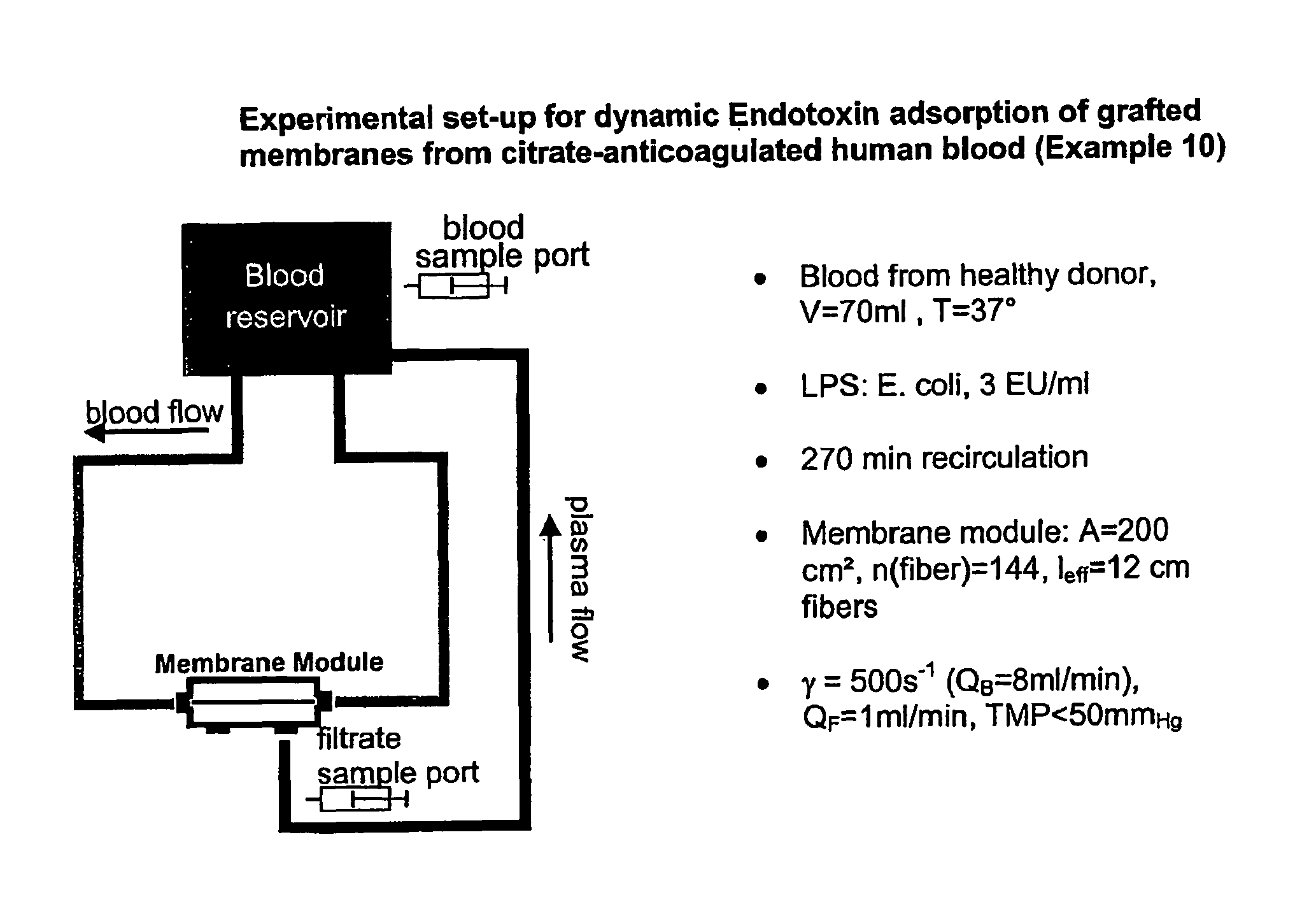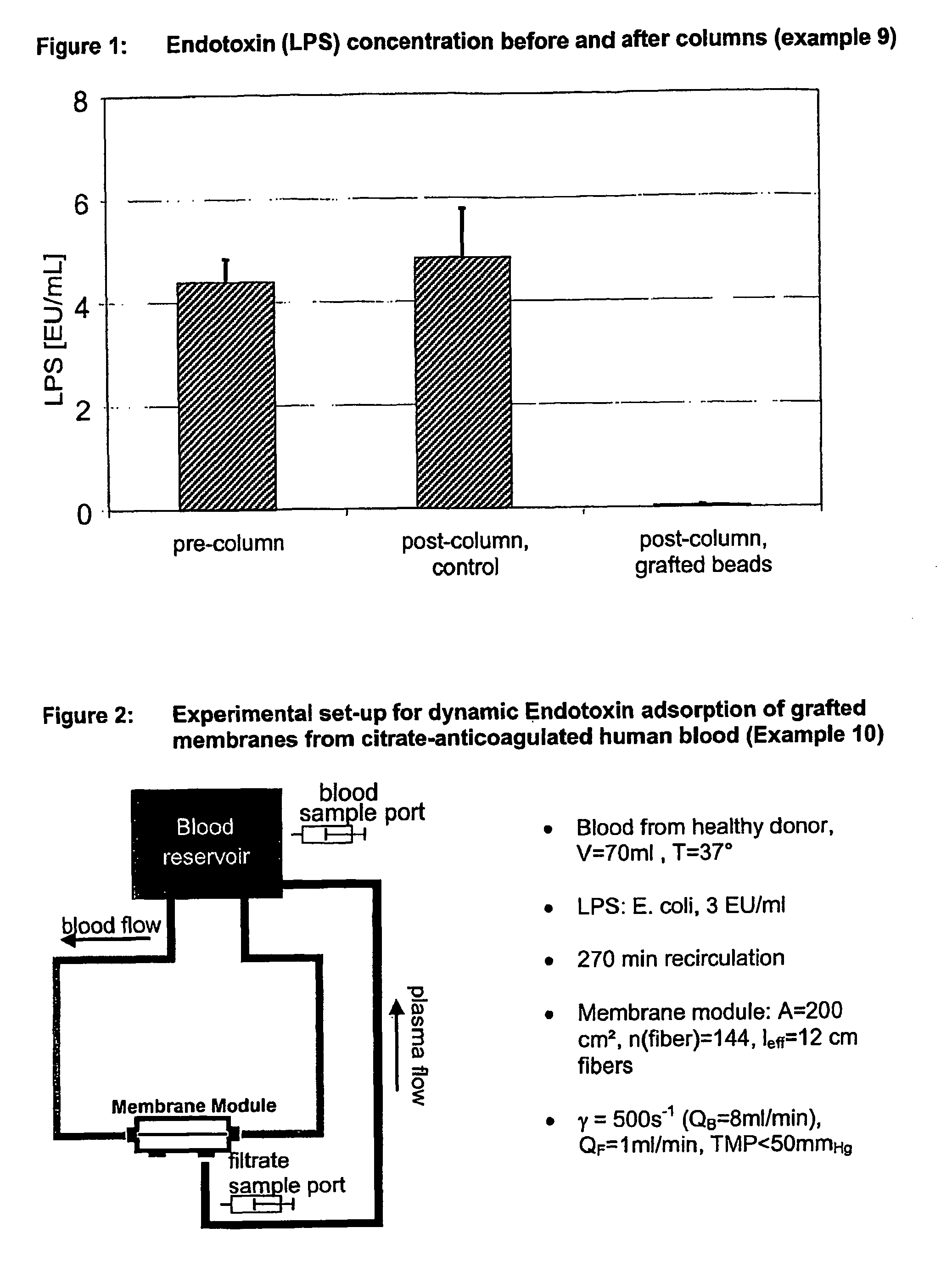[0017]Preferably, the separating material of the present invention is produced by the afore-mentioned method. One
advantage of the present invention is that the method of producing the separating material of the present invention does not require an
organic solvent, such as carbon
tetrachloride, which is difficult to remove from the final product, and which may be toxic or at least harmful to a patient, when the separating material is used in medical applications and extracorporeally contacted to any liquid or
body fluid, which is (re-)introduced into the patient's body.
[0018]Another
advantage of the present invention lies in the covalently
coupling of the
radical initiator to the amino-functional groups on the
solid substrate. Thereby, the occurrence of homopolymerization in the reaction solution is avoided or at least minimized. The radical initiator, which is bound to the
solid substrate, forms radicals upon temperature increase, and part of the radical initiator structure becomes part of the
polymer chains, which are formed from the
solid substrate surface. The polymer chains of the present invention develop from the surface of the substrate without the formation of undesired cross-linkages between the chains, thus the process of the present invention is considered to provide a very “clean”
chemistry.
[0019]Another
advantage of the present invention is based on the use of thermally labile radical initiators, which can be chosen to ensure mild
reaction conditions and to avoid additional reactants which may react with the substrate or the monomers in an undesired manner. The temperatures to initiate
radical formation of useful radical initiators typically lie within the range of 50° C. to 120° C., preferably in the range of 70° C. to 100° C. A useful temperature range of the
polymerization reaction is from the 10 hour
half life temperature of the radical initiator to about 20 to 25 degrees above that 10 hour
half life temperature. By adjusting the
reaction temperature it is further possible to very precisely control the
polymerization reaction, e. g. onset of the reaction,
reaction speed,
degree of polymerization etc.
[0020]In a preferred embodiment of the separating material of the present invention, the
solid substrate is a porous polymeric material. The
porosity of the substrate material provides a large surface area for the contact between the separating material and the fluid.
[0021]An advantageous use of the separating material is the medical application in the
extracorporeal treatment of human or animal blood or other body fluids, e. g.
hemodialysis,
filtration, and / or removal of undesired substances from the blood by adsorption of such substances to the separating material. Usually, in such applications the blood of a patient is extracorporeally separated into the blood cells and the
blood plasma (or
blood serum), the latter containing most of the substances to be removed by the treatment. In another preferred embodiment of the invention the porous polymeric material has a pore size that is sufficiently large to allow passage of
blood plasma, or
blood serum through the substrate material. This allows the
blood plasma or
blood serum to get in contact with the entire surface area within the pores of the separating material. In another embodiment the porous polymeric material has a pore size that is sufficiently large to allow passage of blood
plasma, or blood serum through the substrate material, whereby the pore size is sufficiently small to avoid passage of the blood cells. This allows the use of the separation material, if it is in the form of a membrane or a
hollow fibre membrane, to separate the blood cells from the blood
plasma by passing
whole blood onto or by the membrane. Thereby, the blood cells are retained on one side of the membrane, whereas blood
plasma can pass through the pores of the membrane to the opposite side of the membrane. Thus, blood cells are filtered from the blood plasma. While the blood plasma is passing the separating material membrane, it is contacted within the pores of the material to the
active surface of the material. Thereby, the separating material depletes the blood plasma from undesired substances by adsorption. Afterwards, the depleted or purified blood plasma may be recombined with the blood cells and for example be reinjected into the patient's circulation, or it may be stored for later use.
[0022]The separating material of the present invention may be provided in any form, but preferably is in the form of a membrane, a
hollow fibre membrane, a particle
bed, a fibre mat, or beads. Most preferred it is in the form of a
hollow fibre membrane, as it is for example well known from
hemodialysis applications. Multiple hollow fibre membranes can by known procedures be potted into tubes, and the tubes being fitted with ports in a known manner, to provide separating units, which preferably are in the form of cartridges useful to be inserted into
dialysis apparatuses. If the separating material of the present invention is provided in the form of beads, such beads can for example be packed into columns for the passage of the fluid to be treated, e. g. blood plasma.
 Login to View More
Login to View More 


